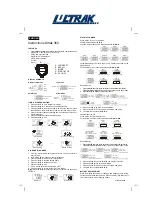
Operation Guide 2514/2645
3
How a Radio-controlled Watch Works
What is a radio-controlled watch?
Your radio-controlled watch is designed to receive a time
calibration signal that contains standard time data and adjust its
current time setting accordingly.
Signal is received using
built-in antenna.
Watch decodes
received data and
converts it to time
data.
Time is adjusted
according to time
data.
Signal data
Cesium
atomic clock
Transmitter
Long-wave time
calibration signal
Internally
Decode
Watch
Time data
After the watch receives the Standard Time signal, it
performs internal calculations to determine the current time.
Because of this, there may be an error of up to one second
in the displayed time.
Calibration Signal
•
The Japanese calibration signal (Call Sign: JJY) is maintained by
the independent Japan Ministry of Posts and Telecommunications
Communication Research Laboratory (CRL). It is a long wave
signal transmitted 24 hours a day from the Mt. Otakadoya
transmitter (40kHz) located in Tamura-gun, Fukushima Prefecture,
and from the Mt. Hagane transmitter (60kHz) located on the
border between Saga Prefecture and Fukuoka Prefecture.
•
The U.S. calibration signal (Call Sign: WWVB) is transmitted by
the National Institute of Standards and technology from Fort
Collins, Colorado.
Though the calibration signal is normally transmitted 24 hours
a day, transmission may be interrupted occasionally due to
maintenance, lightening, etc.
Reception Range
This watch is designed to receive the standard time calibration signal of Japan (JJY) or of the United States (WWVB). The signal that is
received depends on the current Home City setting.
•
For information about selecting a Home City, see “To manually set the time and date”.
Home City
TYO
LAX, DEN, CHI, NYC
Transmitter
Either the Mt. Otakadoya signal (40kHz) or the Mt.Hagane signal (60kHz)
Fort Collins, Colorado signal
1000km
Mt. Hagane
(60kHz)
500km
1000km
500km
Transmitter Location
Mt. Otakadoya
(40kHz)
•
Under optimum conditions, the calibration signal should be
receivable up to 1,000 kilometers from the transmitter.
•
Note that the wave is relatively weak at distances greater than
500km, so reception may be poor at long distances.
Fort Collins
3000km
1000km
Transmitter Location
•
Under optimum conditions, the calibration signal should be
receivable up to 3,000 kilometers from the transmitter.
•
Note that the wave is relatively weak at distances greater than
1,000km, so reception may be poor at long distances.
❚
Time Required for Reception
Signal reception takes anywhere from about two to six minutes.
•
Note that when “FREQ. AT” is specified as the frequency selection
mode, signal reception can take up to 12 minutes.
•
See “Specifying the Transmitter Mode” for more information.
❚
To trigger reception manually
Hold down the
A
A
A
A
A
button for
about two seconds.
•
The watch beeps and reception starts.
Ongoing reception is indicated by the
“
” icon and the receive indicator.
❚
To stop signal reception
Press the
A
A
A
A
A
button.
•
All other buttons besides
A
are disabled during signal reception.
When reception is successful
After reception is complete, the watch adjusts its current time
setting and then its current date setting.
•
The “
” icon and the receive indicator remain on the display to
indicate that reception was successful.
When reception fails
The watch does not adjust its current time setting, and displays
“ERROR!” instead.
•
The display will return to the normal timekeeping screen
automatically if you do not perform any operation for about one or
two minutes.
❚
Receive Icon and Indicator
While reception is in progress, the
“
” icon and the receive indicator
cycle from “Unstable” through
“Stable” as shown below. How far
they cycle depends on the signal
strength.
Keep the watch in a location where
reception is stable while reception is
in progress.
Unstable
Stable
•
Even under optimum reception conditions, it can take about 10
seconds for reception to stabilize.
•
Use the receive icon and receive indicator to check
reception status and to determine the best location for
signal reception.
•
Note that weather, the time of day, surroundings, and other
factors can all affect reception.
Receive Icon
Receive Indicator
Location
Reception is difficult and may even be impossible in the locations
described below. Avoid such locations when performing signal
reception.
•
You should think of your watch operating like a radio or TV when it
is receiving the calibration signal.
If you are experiencing problems with reception, move away
from the types of locations described above to a location with
better reception, and try again.
Near high-voltage lines
Among or near buildings
Next to a household appliance or
office equipment (TV, speaker,
fax, PC, mobile phone, etc.)
Inside a vehicle
(automobile, train, plane, etc.)
Near mountains
In a location where there is radio
interference
(construction site, airport, etc.)
Receiving the Calibration Signal
There are two methods you can use to receive the time calibration
signal.
•
Auto reception (Reception is performed automatically at 2:00,
4:00, and 6:00 each morning.)
•
Manual receive (You initiate reception using a button operation.)
•
The watch is set up for auto reception at the factory, so all you
need to do is to place it in a location that allows good reception
each night.
❚
To make reception easier
Remove the watch from your wrist and place it somewhere so its
top (12 o’clock side, where the antenna is located) is facing
approximately in the direction of the signal transmitter. Keep it
away from metal objects.
Resin band
Metal band
•
Orienting the watch so it is sideways to the transmitter makes it
more difficult to receive the signal.
•
Do not move the watch while it is receiving the calibration signal.
•
Geographic contours, nearby buildings, the season, the time of day, can even make reception impossible even when you are within range of
the transmitter.
•
Best reception is possible late at night.

























